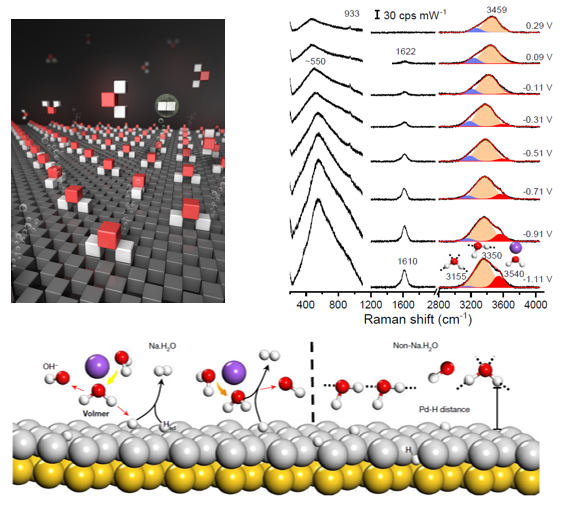On December 2, 2021, Professor Jian-Feng Li, a member of the lab, cooperated with Professor Pan Feng from Peking University Shenzhen Graduate School, published a paper in Nature entitled In situ Raman spectroscopy reveals the structure and dissociation of interfacial water, which revealed the properties of interfacial water and their effects on the electrocatalytic hydrogen evolution reaction (HER) using in-situ electrochemical Raman spectroscopy.

Figure. The in-situ Raman spectra and dissociation process of interfacial water.
Water molecules play a vital role in various domains of science. The comprehension and management of water molecules at the electrode/solution interface lays the foundation for progress in surface science, catalysis and energy science. Especially, water molecules directly participate in many important electrocatalytic reactions, such as hydrogen evolution reaction (HER), oxygen evolution reaction (OER), carbon dioxide reduction reaction (CO2RR), oxygen reduction reaction (ORR), nitrogen reduction reaction (NRR), etc. However, interfacial water is notoriously difficult to probe owing to the interference from bulk water and the complexity of interfacial environments. At the core of the above electrocatalytic processes is the structural evolution of interfacial water as a function of applied potential, which necessitates in-situ characterization of water molecules at electrode surface (especially atomically flat single crystal surface), and more importantly, a realistic model of the corresponding structure-activity relationship in electrocatalysis.
Based on the shell-isolated nanoparticle-enhanced Raman spectroscopy (SHINERS) technology invented by the research team (Nature, 2010, 464, 392-395), this work achieved the in-situ monitoring of the structure and dissociation of interfacial water at Palladium single crystal electrode/solution interface during HER process. The authors found that the interfacial water molecules were constituted by both the hydrogen-bonded water and the cation hydrated water. The cooperation of cations and negative potential assigns an ordering to the interfacial water, such that the cation hydrated species are dragged closer to the electrode surface than the hydrogen-bonded counterpart. This scenario improves the charge transfer efficiency between the interfacial water molecules and the electrode surface, thus greatly boosting the HER rate. A higher concentration or valence state of the cations will impose an increased degree of ordering to the water molecules at the interface and further improve the HER performance. The central role of cation hydrated water was also substantiated by the intimate correlation between the content of cation hydrated water and HER rate on various facets and with different electronic structures, implicating that such rationale can be generalized to other material systems.
The observation and analysis of interfacial water structure have opened up an avenue to explore the mechanism of surface reactions and manipulate the water chemistry for targeted application. With a wealth of experimental evidence and theoretical simulations, the research team found that cations in aqueous solutions can effectively tune the catalytic efficiency via the "co-catalytic" effect. As a consequence, the composition and structure of electrolyte solution (such as cation concentration and valence state of hydration) and solid-phase interface structure can jointly exert their influence on the catalytic reactions, which is a kind of co-catalytic effect. This work provides a robust and adaptive strategy for improving the electrocatalytic reaction rate.
This work was conducted under the supervision of Professors Jian-Feng Li and Feng Pan. Professors Zhong-Quan Tian, Gary Attard, Zhi-Lin Yang, and Associate Professor Jin-Chao Dong participated in the discussion of the work. Dr. Yao-Hui Wang, who has graduated from College of Chemistry and Chemical Engineering, Xiamen University, and Shi-Sheng Zheng from Peking University Shenzhen Graduate School are the co-first authors of this work. Ru-Yu Zhou, Quan-Feng He, and Peter Radjenovic from Xiamen University participated in the experiment and manuscript preparation. Shun-Ning Li and Jia-Xin Zheng from Peking University Shenzhen Graduate School participated in the ab initio molecular dynamics simulations. The electromagnetic field simulation was completed by Wei-Min Yang, a doctoral student of the College of Physical Science and Technology, Xiamen University. This work is supported by the national key R&D project and the National Natural Science Foundation of China.
Full link:https://www.nature.com/articles/s41586-021-04068-z